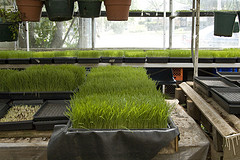I have come across a lot of information on the internet, magazines and newspaper articles about wheatgrass side effects. Equally, I have also discovered through the same means that there are huge volumes of info about its benefits as well. However, some of these pieces of information I have read seems outrageous and supported with little scientific evidence. I will share some of these benefits as well as the side effects of this popular health drink with you.
First, let us look at some brief background information about the wheatgrass. This is a plant that belong the grass family. Its shoots, roots and rhizome are used in the extraction of medicine. It is also used as a chief source of nutrients such as iron, magnesium, calcium, amino acids as well as vitamin A, C and E. Due to its medicinal value, wheatgrass is predominantly used in the treatment of major ailments. However, despite of these claims, very few clinical trials have been done to support its efficacy.
Wheatgrass Benefits
Wheatgrass benefits include, but not limited to boosting the production of hemoglobin, preventing took decay and bacterial infections, enhancing wound healing as well as disorders related to blood sugars like diabetes. It is also used in removing of carcinogenic materials, drugs as well as heavy metal deposits from the body. Several people also use the wheatgrass to prevent graying of hair, enhancing digestion, reducing hypertension and lowering body cholesterol levels by blocking its assimilation.
Wheatgrass is commonly used in the treatment of urinary tract disorders such as infection of the prostrate, urethra and bladder. Others kidney disorders may include kidney stones and benign prostatic hypertrophy (BPH). The popular health drink is used alongside other mild diuretics to increase urine flow. It is also used in the treatment of respiratory tract infections like bronchitis, disorders of the liver, severe skin problems, joint aches, gout, and ulcerative colitis. It is also used as flavoring ingredient in food and beverages.
Wheatgrass Side Effects
Despite of its numerous benefits, wheatgrass has several mild side effects. These include allergy, headaches, stomach upsets and nausea. Of the three allergic reactions, nausea is the most prevalent side effect. It is usually felt shortly after taking the juice or powder. The cause of the nauseating effect may be attributed to the direct effect of the wheatgrass or allergic reactions to the ingredients contained in the drink.
Headaches are generally relatively mild. In case the headache persists, the individual should discontinue using the drink and consult a medical practitioner. Detoxification process is usually purported to be the main cause of headaches rather than the wheatgrass. However, as I mentioned earlier, these kinds of claims are yet to be scientifically determined. An overdose of the poplar drink can also cause diarrhea and other stomach upsets. The first time users can also experience short-term stomach problems.
Individuals who react to wheat may experience allergic reactions to wheatgrass in form of rashes or respiratory tract problems like coughing. It is imperative for such kind of people to avoid using the wheatgrass. Consult a doctor immediately in case of any irritation.
The correct wheatgrass dosing depends on a number of factors that include the age, health, etc. Very little is known about wheatgrass side effects on pregnancy as well as breast-feeding on both the mother and the baby. Therefore, it is critical to avoid its use in order to stay safe. Make sure you strictly follow the instructions on the product label to the latter. Above it all, always consult your doctor before using the product to prevent any possible side effects that may arise out of its use.
